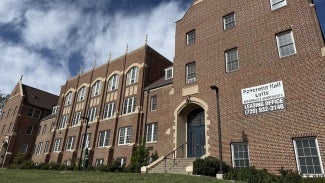
Beyond value engineering: What Pancratia Hall teaches about designing for longevity
A repurposed 100-year-old dormitory illustrates how buildings designed for durability can adapt to radically different uses across generations. AIA partner Concrete Masonry Checkoff explains.
In the 1920s, Pancratia Hall opened as a collegiate Gothic dormitory at Loretto Heights College in Denver. Its designers chose massive load-bearing concrete masonry walls, which were a practical choice for strength and fire safety.
Nearly a century later, after years of vacancy, the building was transformed into 74 units of affordable housing. The most striking part of the story wasn’t the new use, however, but the condition of its structure. The original walls remained intact and required only minimal repair.
Pancratia Hall illustrates an essential point: When architects design buildings with durability in mind, they can adapt to radically different uses across generations. It also raises the timely question of how often today’s projects set themselves up for long-term relevance.
The limits of “cheaper now”
Too often, building owners and developers see value engineering as a win. The goal is to reduce costs today, meet the budget, and move on. But architects know the potential downstream effects, including maintenance headaches, premature system failures, and inflexible structures that resist adaptation.
Pancratia Hall provides a counterexample. The choices made 100 years ago created a building strong enough to withstand changing needs, ownership transitions, and economic cycles. Its long service life is a reminder that architecture is judged not only on opening day but on its capacity to remain useful a century later.
When a school needs to become a community center or a warehouse needs to find a new purpose as housing, structural durability determines whether adaptation is feasible or demolition is necessary. The true cost of architecture isn’t in the low bid—it’s in whether the building still stands and serves.
Material choice and modern aesthetics
Pancratia Hall’s survival speaks to both construction technique and design intent. Durable assemblies offer a kind of redundancy—walls that don’t need frequent repair and structures that don’t collapse under heavy stress.
The bonus is that durability no longer comes at the expense of beauty. For example, today’s concrete masonry offers a design palette far broader than the gray block many still picture. Architects can specify split-face, burnished, ground, or glazed finishes; select from a range of colors; and explore varied unit sizes that allow facades to read as clean and monolithic or textured and dynamic.
In schools, civic buildings, and cultural spaces, designers are using masonry to achieve both performance and expression. It can serve as a durable backbone while also delivering visual richness that complements steel, glass, and timber. In that sense, masonry has evolved from a utilitarian choice into a flexible tool that supports architectural creativity as well as resilience.
From intuition to evidence
Stories like Pancratia Hall resonate, but today’s clients expect more than anecdotes. They want numbers, frameworks, and documentation to justify decisions. AIA provides tools that help architects move from intuition to evidence:
- The Resilience Design Toolkit evaluates how materials and systems perform when facing fire, flooding, and extreme weather.
- The Embodied Carbon Toolkit measures lifecycle impacts to show how long-lasting assemblies reduce carbon over time.
- The Framework for Design Excellence positions adaptability and reuse as part of the design conversation from the outset.
- MasterSpec ensures details are specified with rigor, protecting against shortcuts that undermine performance.
These tools don’t prescribe materials but rather strengthen architects’ ability to advocate for long-term thinking. They provide the language and data that architects need to educate clients who may be focused on initial costs.
Rethinking the conversation
Architecture is a long game. The projects of today will face conditions no one can fully predict, from new program needs to a changing climate. That makes the temptation to design for short-term savings precarious. The real question is whether a building will still be standing, adaptable, and useful in 2125.
For those exploring how resilient, adaptable materials can support both design intent and long-term performance, organizations like the Block Design Collective offer free technical guidance and project support. To learn more, visit The Beauty of Block or connect with Tino Kalayil at tkalayil@blockdesign.org.
AIA does not sponsor or endorse any enterprise, whether public or private, operated for profit. Further, no AIA officer, director, committee member, or employee, or any of its component organizations in his or her official capacity, is permitted to approve, sponsor, endorse, or do anything that may be deemed or construed to be an approval, sponsorship, or endorsement of any material of construction or any method or manner of handling, using, distributing, or dealing in any material or product.
